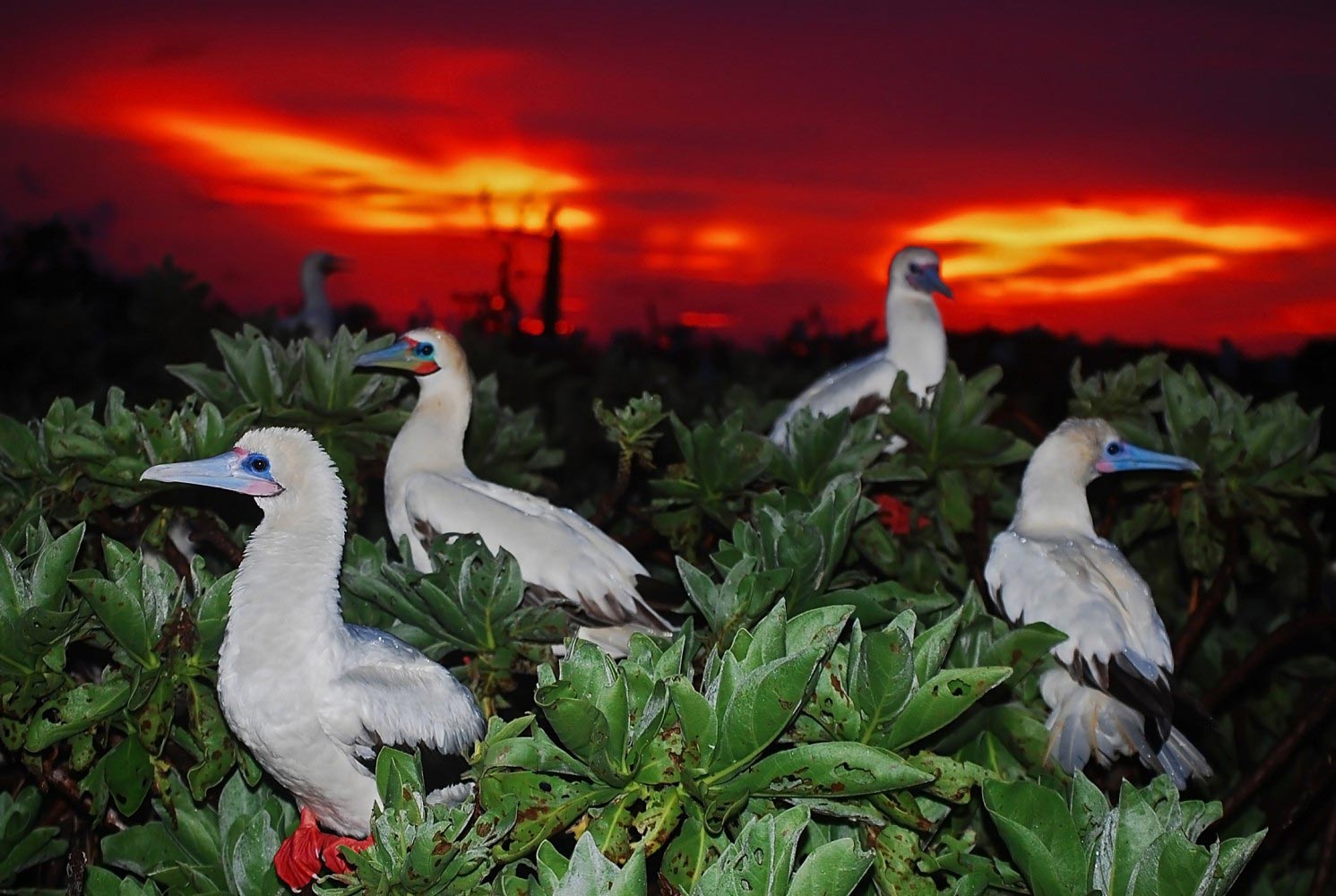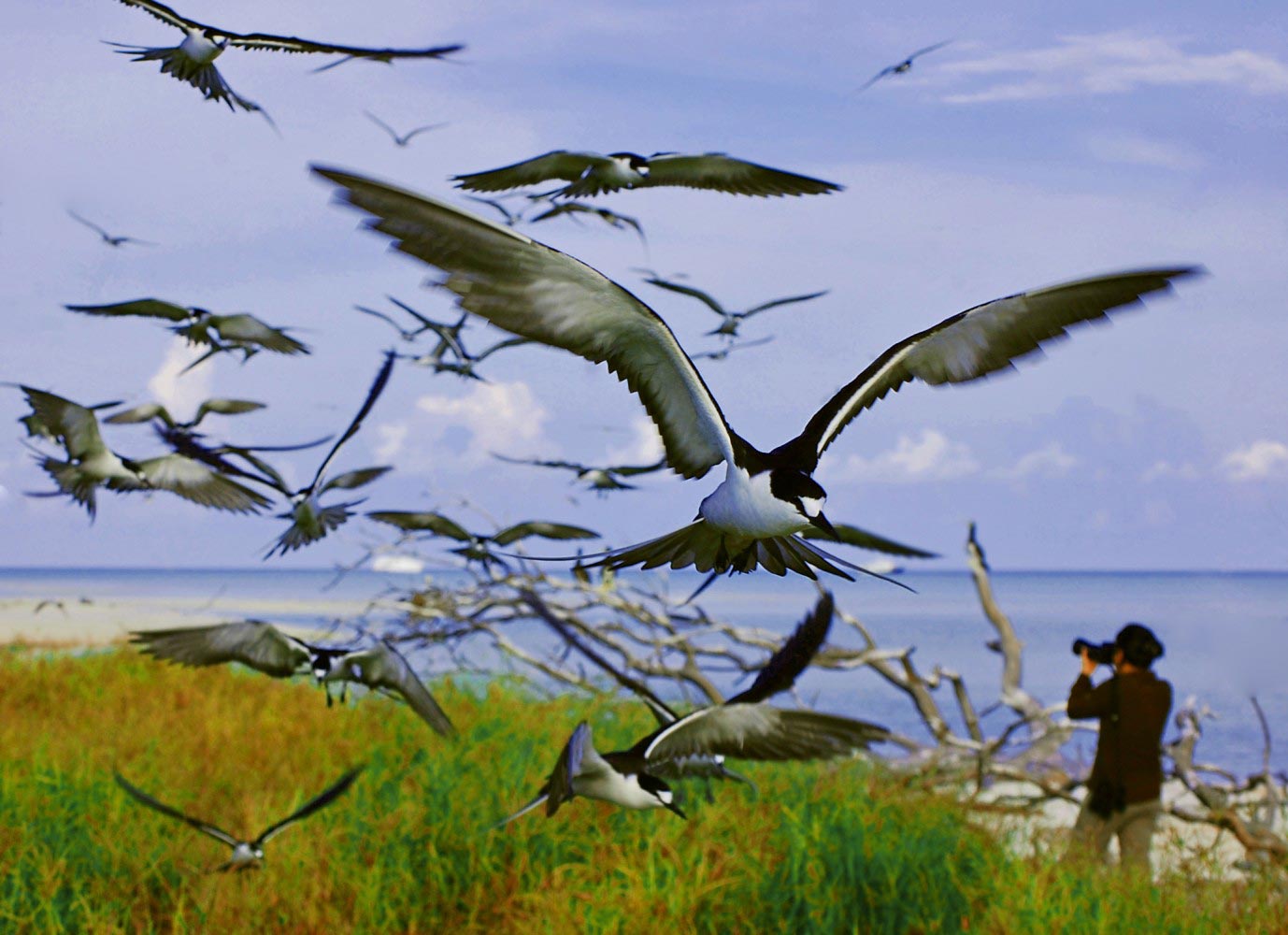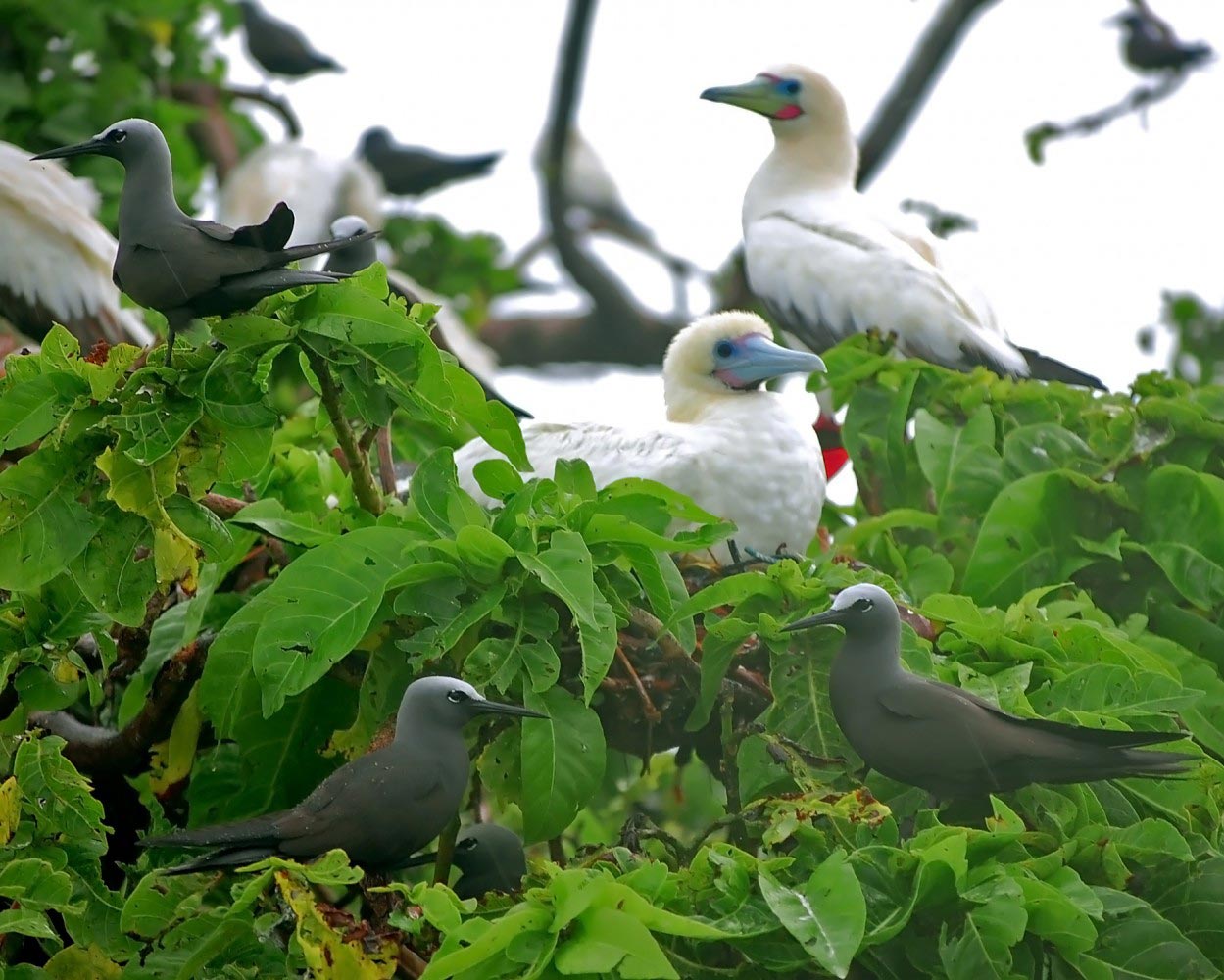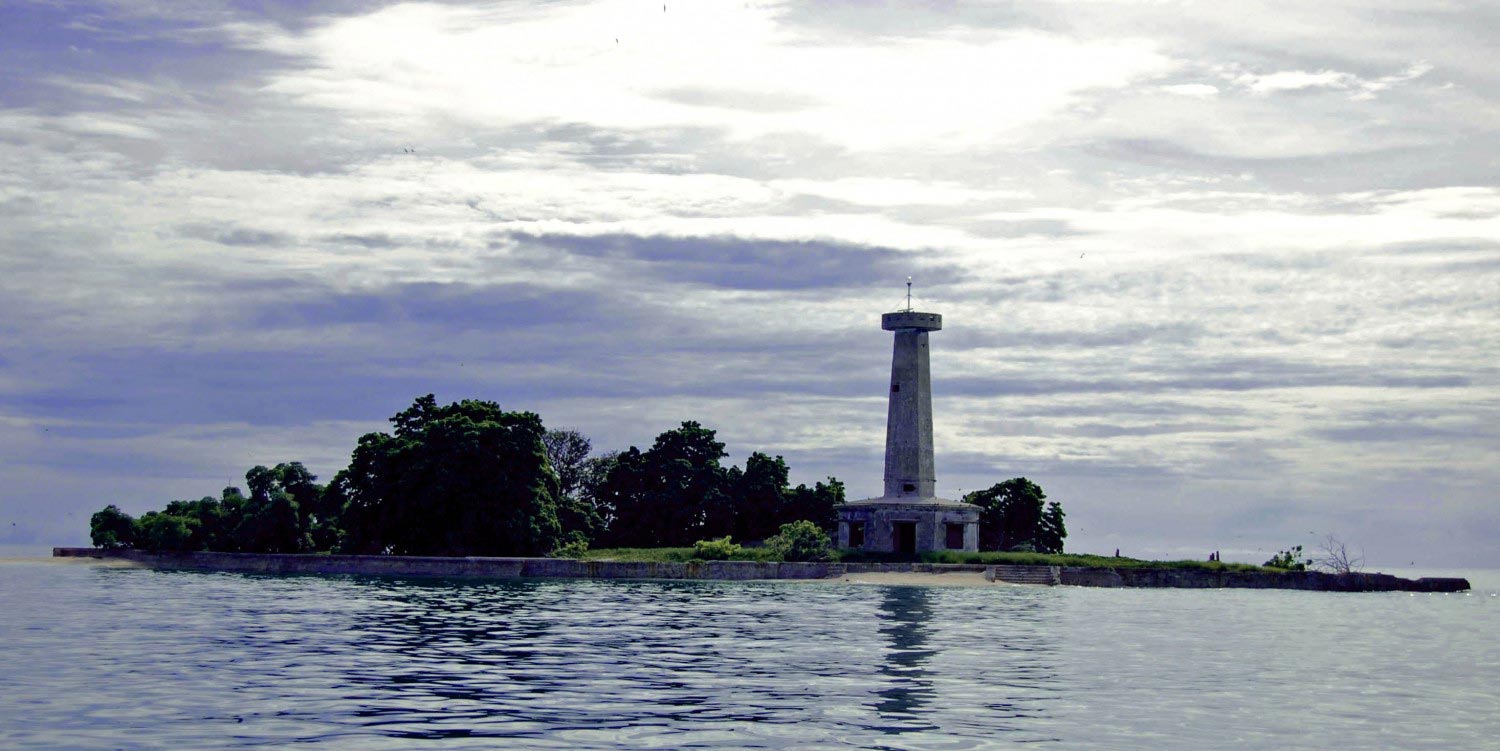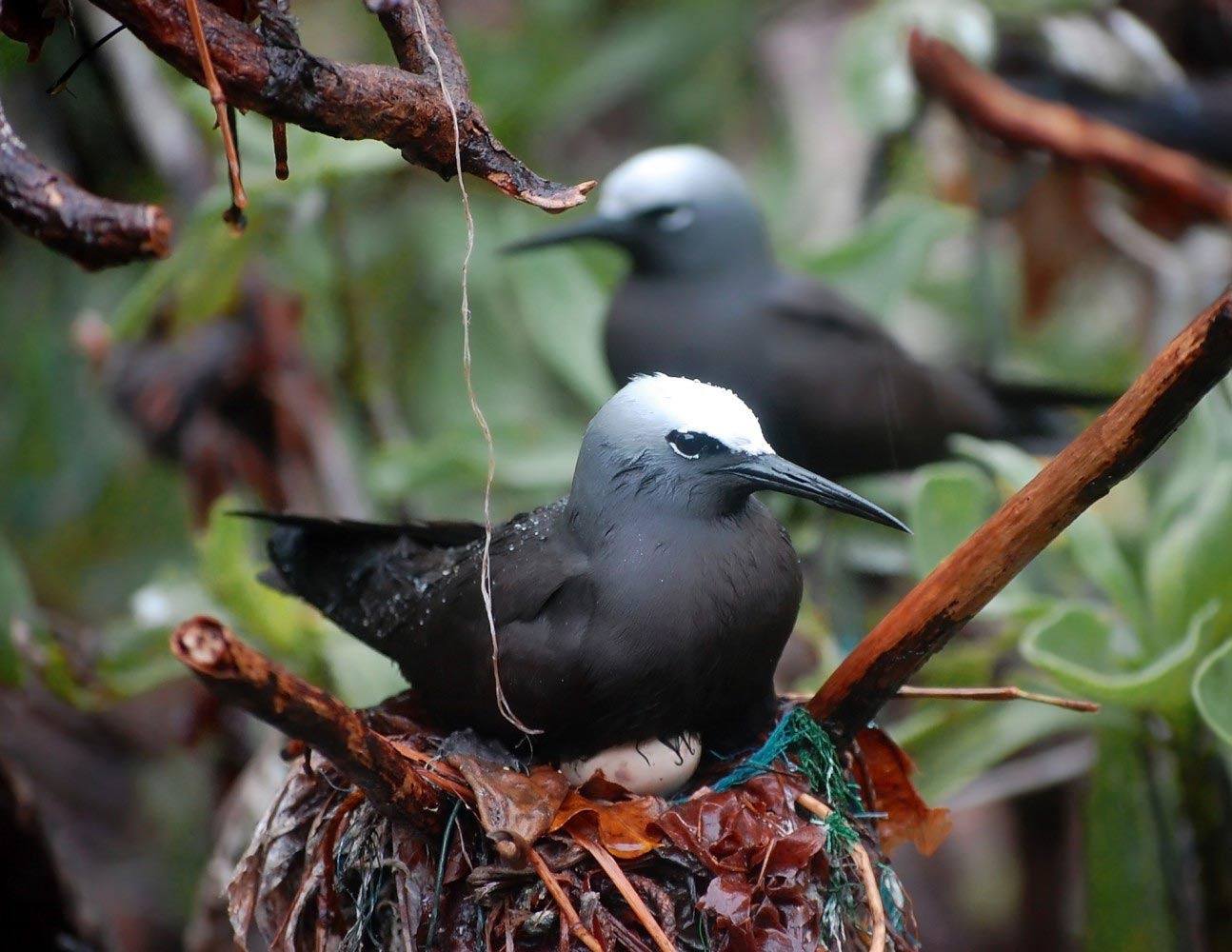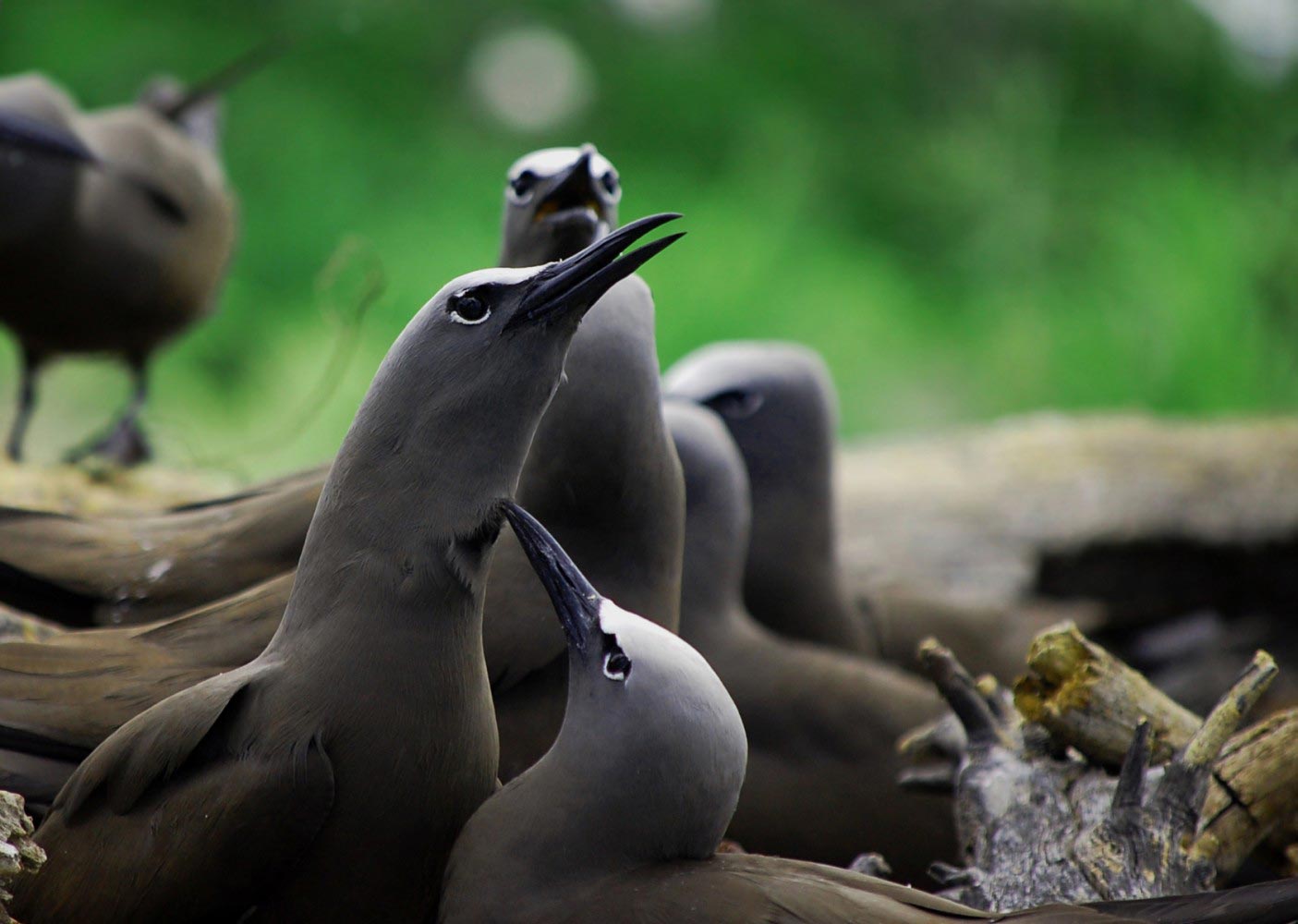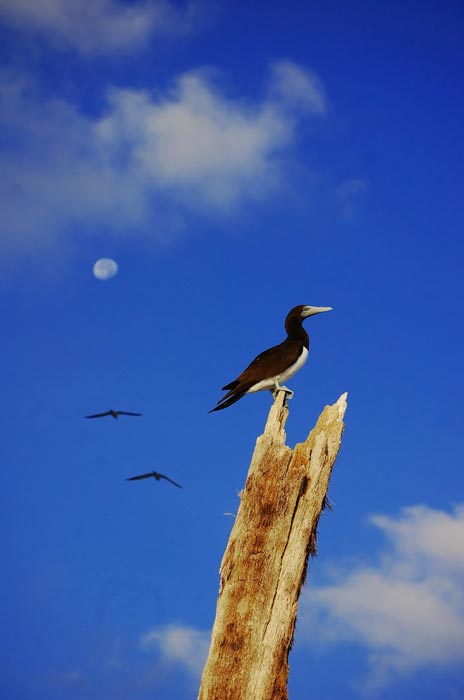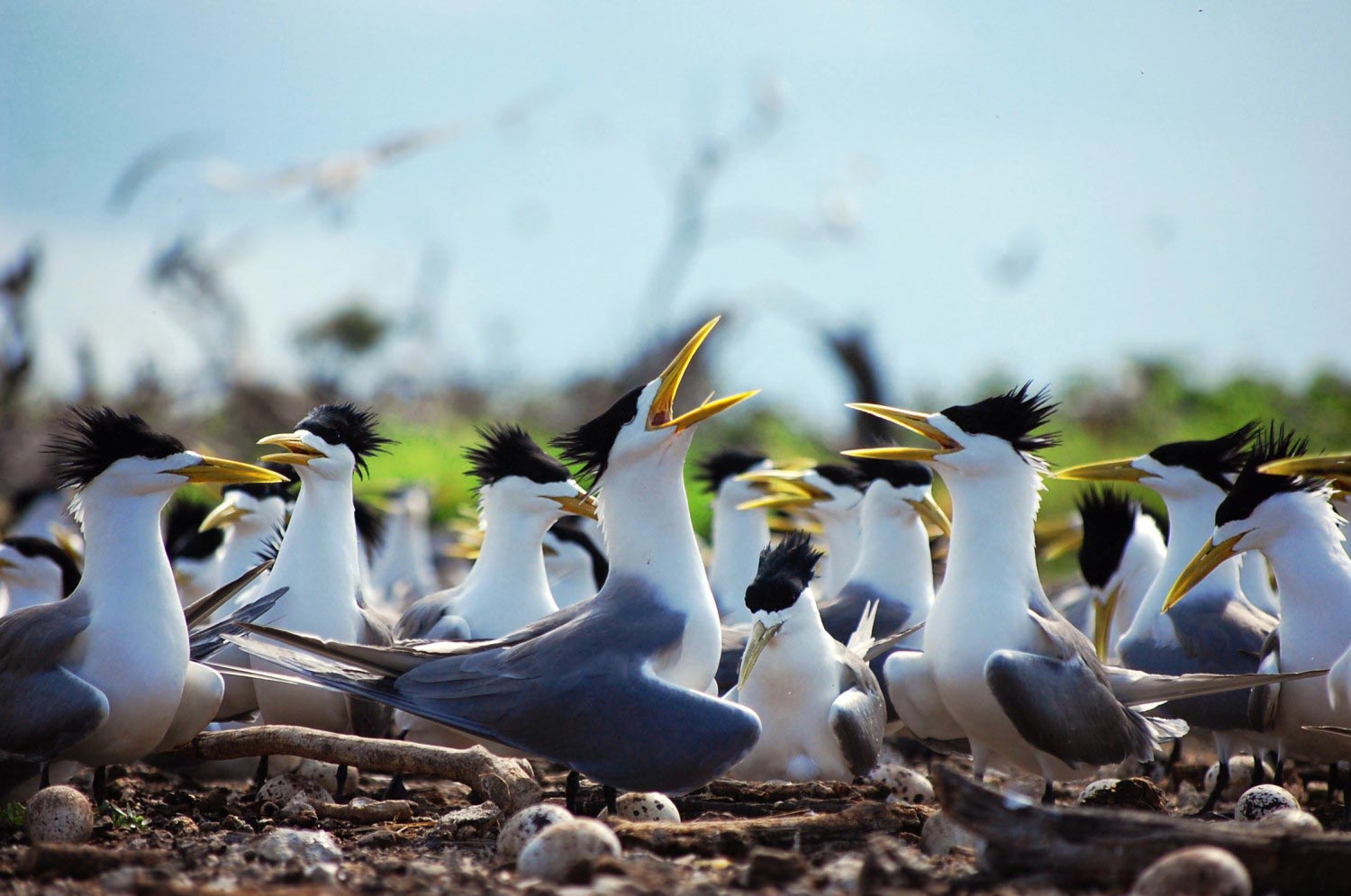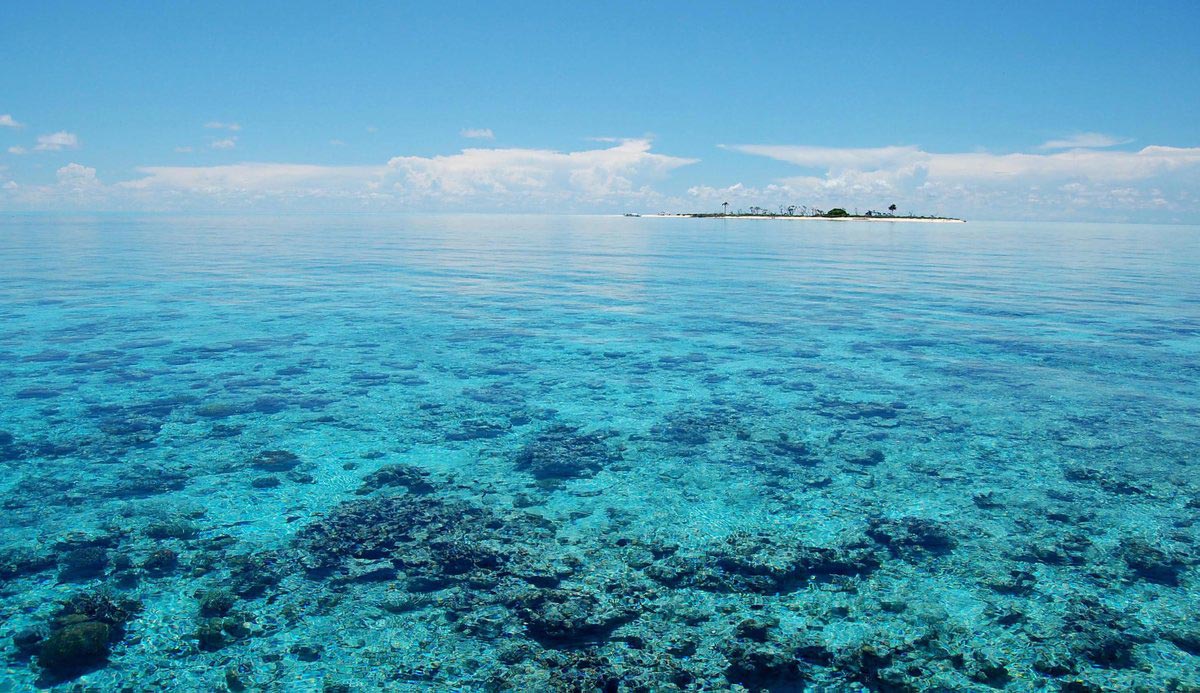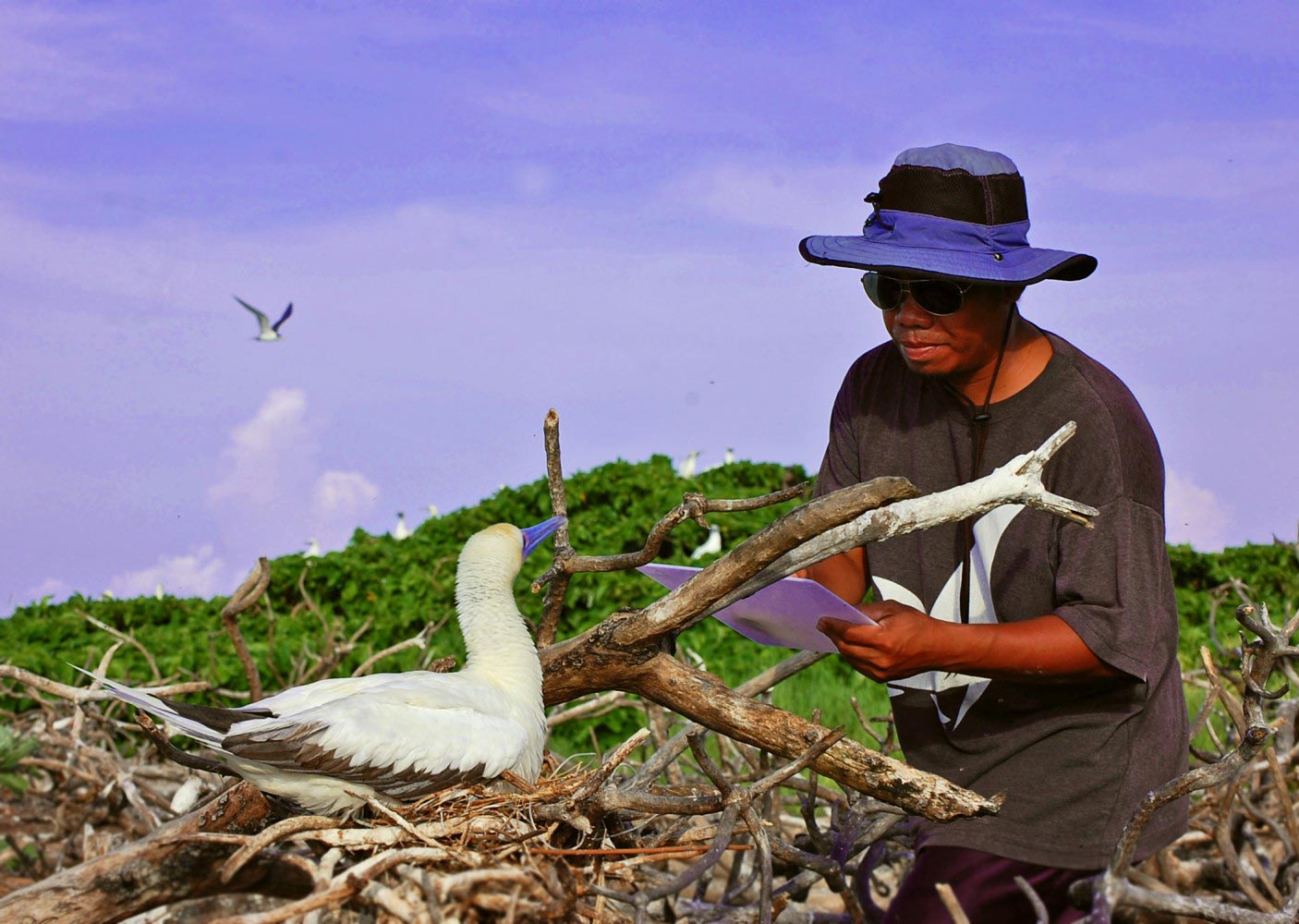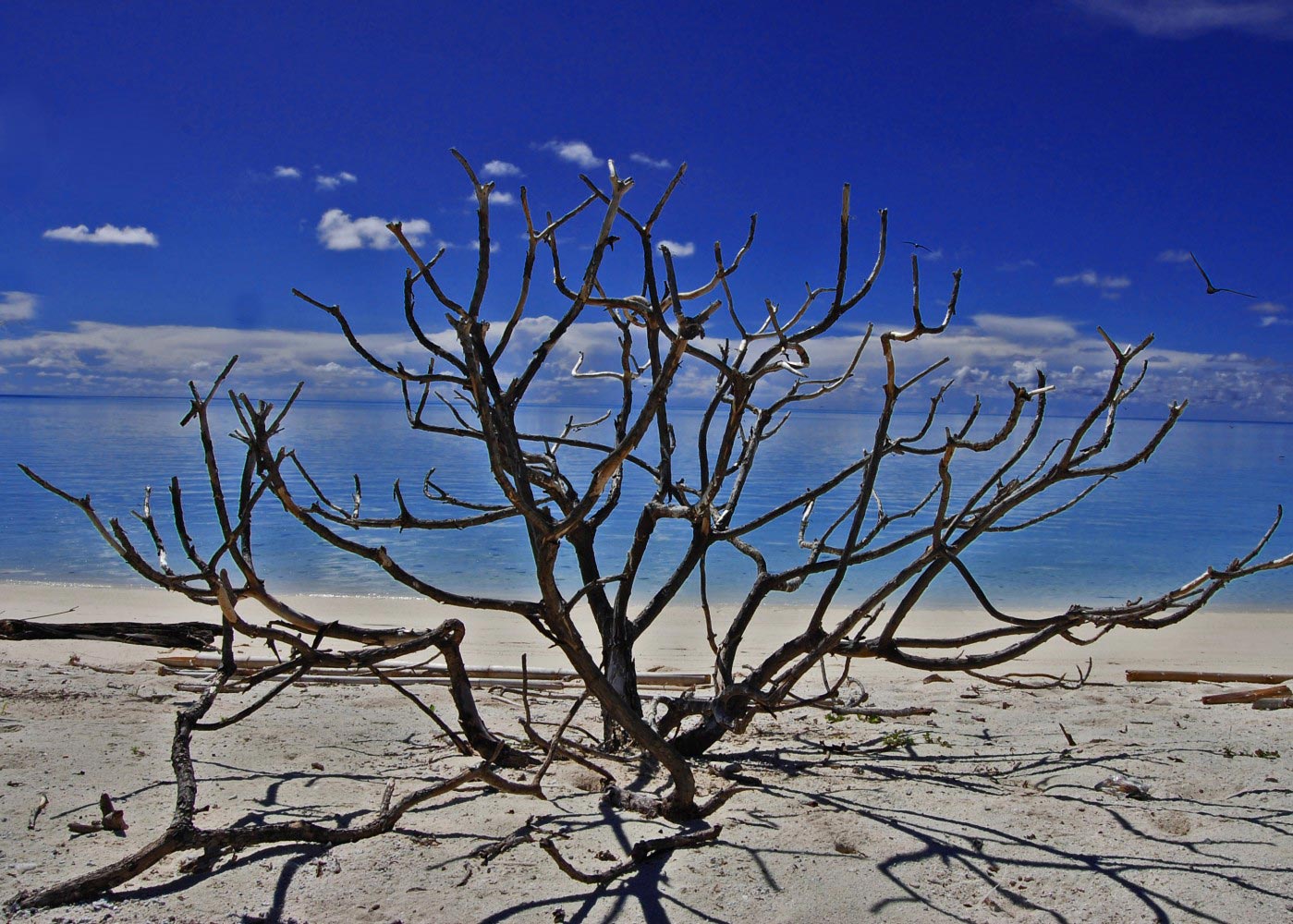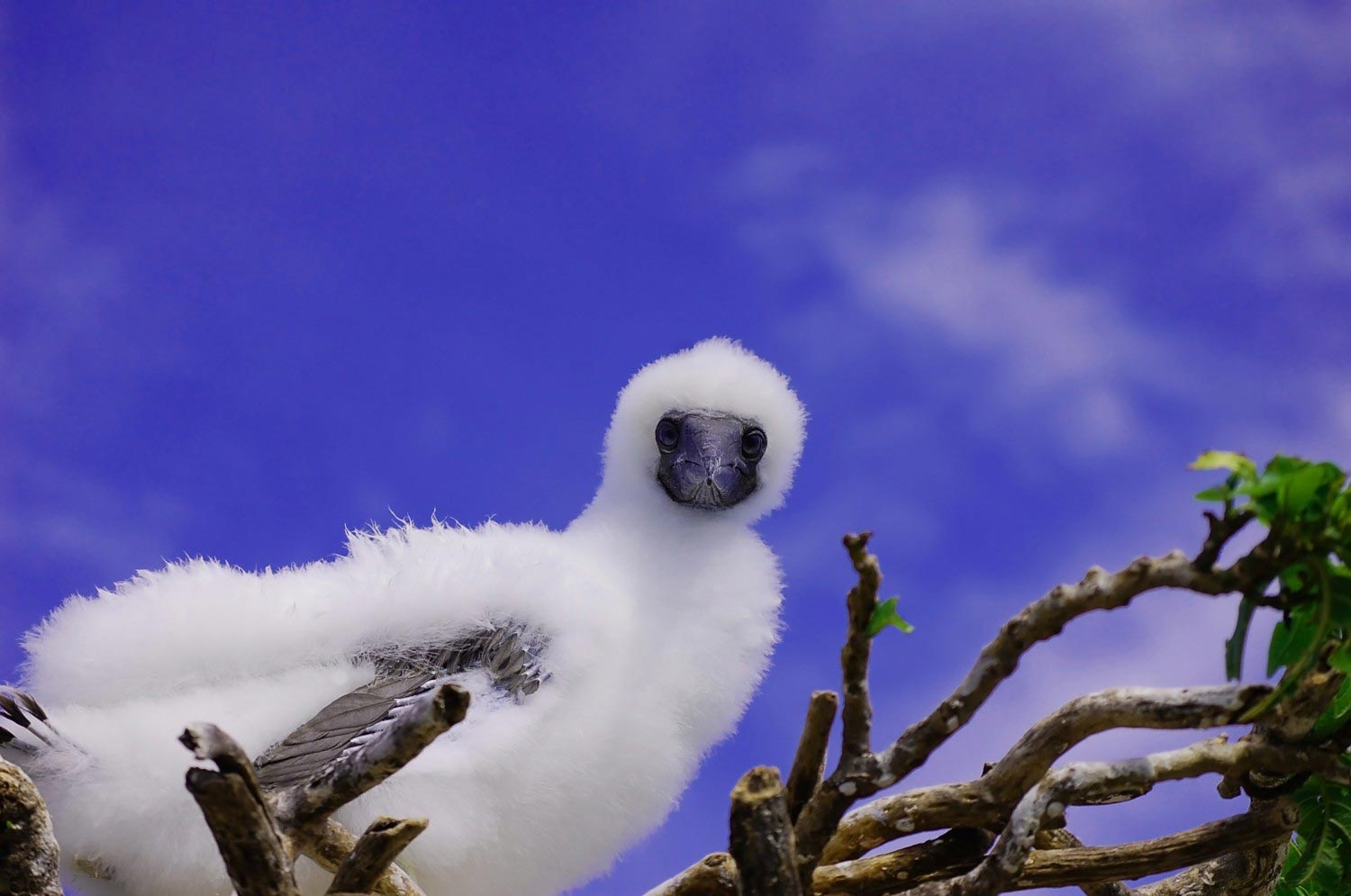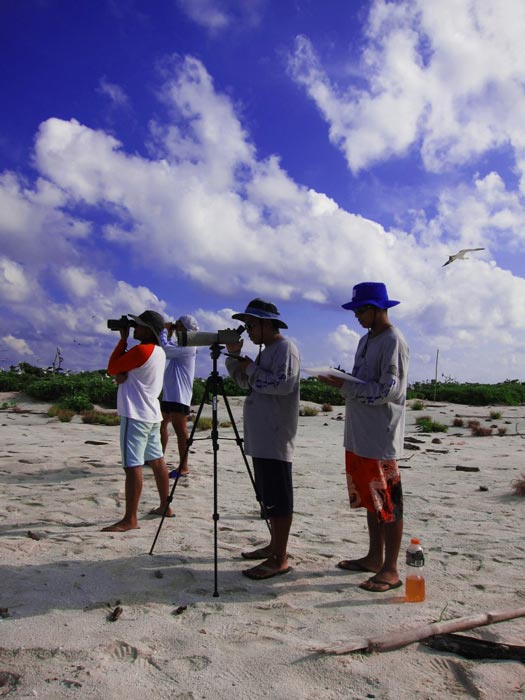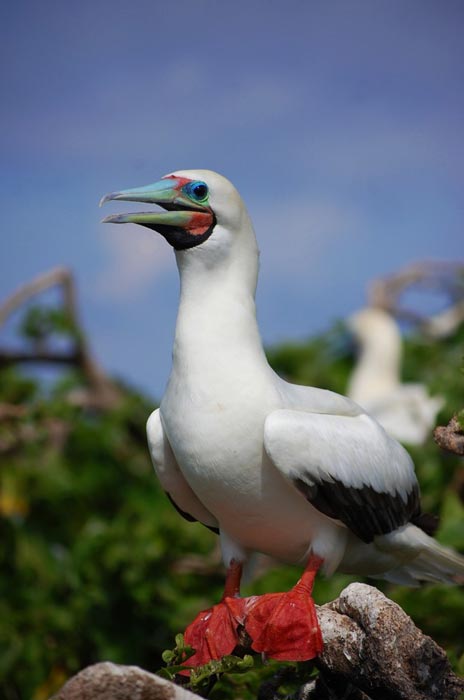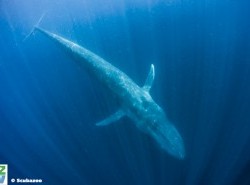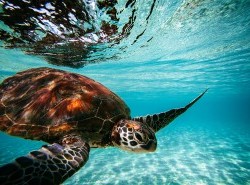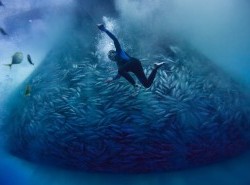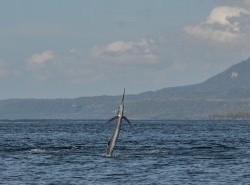The combined stench of rotting fish and guano is incredible. Soaked and shivering, we shelter beneath a dripping grove of Argusia trees on Tubbataha’s South Islet and count birds. Chilly raindrops are the least of our concerns – more exciting things are falling from above. I wipe steaming gobs of fresh seabird guano from my hat, shoulders and writing slate then trail my partner through the dense brush.
“Nine Black Noddies in five tree nests,” observes my partner, Tubbataha Management Office (TMO) Ranger Segundo ‘Seconds’ Conales. I strain to hear above the cacophony of over 20,000 seabirds, periodically silenced by resounding claps of thunder. The birds are everywhere – flitting in and out of foliage, perched atop rocks, forming a dense cloud above the island. Every few seconds, one leaves the safety of its perch to snatch a damp twig, leaf or piece of plastic from the ground. We tread lightly, visions of Alfred Hitchcock’sThe Birds springing to mind. I jot the latest numbers on my waterproof plastic slate and push on.It is a drizzling day in May and we are back in Tubbataha. Led by Danish ornithologist Dr. Arne Erik Jensen, we are assessing the seabirds of Tubbataha North and South Islets as part of a nine-year old annual initiative by the Tubbataha Management Office (TMO) and World Wide Fund for Nature (WWF) to conserve the birds of the Sulu Sea. I had last been back in 2008 and still recalled Dr. Jensen’s advice when counting his beloved birds.
“Never look up with your mouth open.”
Tale of Two Islets
At the heart of the Sulu Sea lie the twin atolls of Tubbataha, a spectacular world brimming with wealth both beneath and beyond the blue. Borne of geological action but restrained by the vicissitudes of the sea, the two isles form the Philippines’ last great seabird rookery.In 1911, American naturalist Dean Worcester first set foot on Tubbataha North Islet, also called Bird Islet. It was then a barren sandy island of 60,000sq m, where sea and sand danced ceaselessly. A hundred one years later, the isle has shrunk to 12,435sq m but now hosts over 200 trees, the tallest shredded by a recent boom of Red-footed Boobies. At the centre lies the Plaza – a 3690sq m open area occupied by ground-breeding birds. The scrubby landscape rises no higher than two metres above the sea.Parola or South Islet is much smaller, at 3140sq m. A metre-high concrete wall, cracked and pitted by the elements, forms a protective ring against erosion, while a solar-powered lighthouse erected in 1980 by the Philippine Coast Guard stands sentinel over everything. About 120 Argusia, Pisonia and coconut trees dot the grassy landscape. East of the lighthouse lies the rusting hulk of the Del San, an old log carrier. Protected as a core zone, WWF and Cebu Pacific help TMO in keeping both islands completely off-limits to outsiders.“The isles vary in size each year, for the tide reclaims what geology has proffered. Tubbataha is thus constantly reborn,” says TMO Park Manager Angelique Songco. “Ecologists working in mountains or forests can wait a lifetime to see the kind of habitat change we observe monthly.” I agree, noting that since 2008, trees with back-row views now had front- row seats to the sea.
Holding Out
Prior to the Second World War, seabirds were common throughout Southeast Asia. But four years of ferocious fighting followed by 60 years of extensive human encroachment and marine pollution have taken their toll. Remnant populations have since retreated to a few isolated holdouts like Tubbataha, where the lack of freshwater bars the intrusion of predators like cats, rats and people.When cats were introduced on Ascension Island in the South Atlantic over a century ago, bird numbers dropped from 20 million to 400,000. Guam has already lost 60% of its bird species due largely to the introduction of a slithering slayer, the Brown Tree Snake. Other threats include marine pollution, hunting, land development and climate change.“Six seabird species breed here, distinguished by where they nest,” whispers Seconds as we low-crawl to photograph a cackling colony of Great Crested Terns. “Ground nesters include the Brown Booby, Brown Noddy, Great Crested Tern and Sooty Tern while tree nesters include the Red-footed Booby and the endemic Black Noddy. Each has a distinct personality.”The trip’s top priority was to monitor populations of the Black Noddy, a pigeon-like seabird whose 8000-strong Philippine subspecies survives solely in Tubbataha. Still, we count 3224 nests and 5324 screeching adults on Parola alone.“Though still numerous here, Black Noddies no longer have alternate sites to breed. They are suffering from a housing crisis,” gestures WWF Tubbataha Project Manager Marivel Dygico to a Pisonia tree bursting with both Red-footed Boobies and Black Noddies. In 2001, Tubbataha saw a massive influx of Red-footed Boobies, which nest in the same trees as the Noddies.“The problem is that large flocks of Red-footed Boobies can defoliate whole islands. They tear off leaves for nesting and burn what greens remain with their guano. In seven to ten years, all of Parola’s trees might be gone – unless we control the birds now.” Leafless, some trees on the smaller South Islet are now also lifeless.
Wings of Change
Seabirds play a crucial role in fighting climate change, particularly the threat of rising sea levels, by helping develop island ecosystems. They provide vital fertilizer for nutrient-poor sandbars, allowing the first waves of pioneer plants to survive. Drifting in from nearby islets, seeds of trees eventually take root – further binding the sand, increasing land size and trapping organic sediments – the first steps in producing soil.Fossilized bird droppings also form Phosphorite, a type of rock used for agricultural fertilizer. Phosphoritedeposits have for centuries been mined on small islands and is now of great value for food production.After three days of research under the scorch of sun, the chill of rain and omnipresence of guano, we record a grand tally of 30,100 breeding birds – the highest ever recorded. In comparison, 24,300 were counted last year and 28,000 in 2010. It is estimated that from March to November, an additional 14,000 seabirds roost on Bancauan, Bancoran, Cawili and Basterra Isles – the main hub still being Tubbataha.***Ablaze with sunset hues of scarlet and crimson, Bird Islet descends into night. As the isle prepares for a fresh cycle of rebirth, I whip out my camera and snap a picture of four boobies against the red sky. One soars off and leaves behind a lone egg, bearing a world of promise. Staring at the speckled orb, I consider what Jensen told me that morning.“Tubbataha is the last refuge for many Philippine seabirds. Islands like Bancauan and Cawili once had thousands of them. When people came, they brought with them dogs, rats and cats – all of which eat both ground-breeding birds and their eggs. Today Bancauan only has eight Brown Boobies – and 25 very fat cats.”Before it was declared a National Marine Park in 1988, Tubbataha’s residents had long suffered from exploitation, with generations of fishermen gathering not just fish, but turtles and bird eggs as well. Without continued protection, the sun would probably set permanently on the Black Noddies, Brown Boobies and Tubbataha’s many other winged treasures.Glancing a last time at the dying rays of the sun, I wish the unborn bird luck – and pray that its kind, which has long endured sea-storms and summers for centuries – can weather the winds of change too.
